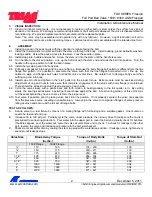
FD9 SERIES Firesafe
Full Port Ball Valve 150# / #300 ANSI Flanged
Installation & Maintenance Manual
1
December 5, 2011
www.a-tcontrols.com
\\Atfs1\Engineering\documents\products\IOM\IOM7015
Brief Introduction
Split body (2-piece) valve allows easy replacement of gasket, seal, and seats without special tools. Series 90D ball
valves use “floating ball” design. Induced by the line pressure the ball is free to move horizontally inside the valve body.
The valve is capable of tight shutoff with flow in either direction or dead-end, regardless of the position of the valve in the
line. The downstream seat, opposite the pressurized side of a closed valve, carries the load exerted by the line pressure
on the ball, while the upstream seat is subject to little load or wear. For this reason, it is sometimes possible to increase
seat life by turning the valve end-for-end in the pipeline.
1. USE:
1.1 Life of valve can be maximized if the valve is used within the rated range, in accordance with pressure, temperature,
and corrosion data.
2. MANUAL
OPERATION:
2.1 To open or close the valve, turn the handle ¼ turn (90 degrees).
A. Valve in Open Position – the handle is in parallel (in-line) with the valve or pipeline.
B. Valve in Closed Position – the handle is perpendicular (crossed) with the valve or pipeline.
3. AUTOMATED
OPERATION:
3.1 Valves with actuators should be checked for valve stem alignment. Angular or linear misalignment will result in high
operational torque and unnecessary wear on the stem seal.
4.
GENERAL INFORMATION FOR ON-SITE INSTALLATION:
4.1 The valve may be fitted in any position on the pipeline.
4.2 To prevent damage to the seats and ball surface, the pipeline must be flushed, free of dirt, burrs, and welding
residues before installing the valve.
5.
DISASSEMBLING & CLEANING THE VALVE:
5.1 If the valve has been used in hazardous media, it must be decontaminated before disassembly.
5.2 As shipped from the factory, valves contain silicone-based lubricant. If silicone is unacceptable for your particular
application, you may disassemble the valve and wash the parts in solvent.
6.
REPLACING THE THRUST WASHER AND PACKING
6.1 Before replacing the thrust washer and the packing, the pipeline must be de-pressurized.
Note: Stem seal leakage may be corrected without replacing the seal and/or packing. Tighten the packing nut to
flatten the belleville washers. If leakage continues or valve’ s operating torque becomes excessive, the seals
are worn and must be replaced.
A.
Remove flange bolts and nuts and lift the valve from the line. Care should be taken to avoid scratching or
damaging serrated gasket. The valves are heavy, and they should be adequately supported before removing
it from the line.
B.
Loosen the stem nut and remove handle and stop plate. Next, remove lock saddle, packing nuts, belleville
washers and gland.
C. Remove body bolt nuts, using proper wrench. Lift off body end. One seat should come out with the body end.
D. Remove body seal.
E. To take out the ball, rotate stem so ball is in fully closed position. Lift ball from the body, using a strap and lift
device, if necessary. Extreme caution should be taken to avoid damage to the ball.
F. Take out the other seat.
G.
Stem must be removed from inside the body. A tap to the top of the stem should loosen it. The thrust washer
should come out with the stem. Then, remove the stem packing.



